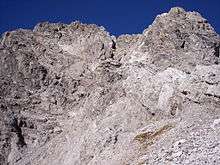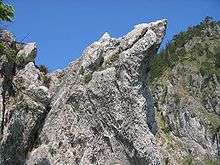Main dolomite
For the formation in Austria, see Hauptdolomit Formation.
| Main dolomite Hauptdolomit Stratigraphic range: Carnian & Norian ages, Late Triassic Epoch, Mesozoic Era | |
|---|---|
 Main Dolomite Formation, exposed in the Northern Limestone Alps. | |
| Type | Geological formation |
| Thickness | 0–2,200 metres (0–7,218 ft) |
| Lithology | |
| Primary | Dolomite (rock) |
| Location | |
| Region |
Limestone Alps and Apennines ranges, Central Europe |

Main dolomite of the Langbathscholle, Kaltenbachwildnis, Austria
Main dolomite (also Main Dolomite, German: Hauptdolomit, Italian: Dolomia Principale) is a lithostratigraphic unit in the Alps of Europe.
Geology
The formation is found in:
- the Northern Limestone Alps and Southern Limestone Alps of the Limestone Alps, a mountain system of the western and Central Eastern Alps.
- the Apennines in Italy
It is primarily made of dolomite rock, ranging 0–2,200 metres (0–7,218 ft) in thickness. The formation was deposited in shallow lagoons during the Late Carnian and Early Norian ages of the Late Triassic epoch in the Triassic Period, during the Mesozoic Era..
Fossils
Fossil prosauropod tracks have been reported from the formation.[1]
See also
References
- ↑ Weishampel, David B.; Dodson, Peter; and Osmólska, Halszka (eds.): The Dinosauria, 2nd, Berkeley: University of California Press. Pp. 517-607 ISBN 0-520-24209-2
| Triassic Period | ||
|---|---|---|
| Lower/Early Triassic | Middle Triassic | Upper/Late Triassic |
| Induan |Olenekian | Anisian | Ladinian | Carnian | Norian Rhaetian |
This article is issued from Wikipedia - version of the 11/2/2016. The text is available under the Creative Commons Attribution/Share Alike but additional terms may apply for the media files.